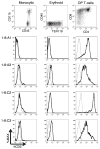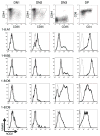Complete TCR-α gene locus control region activity in T cells derived in vitro from embryonic stem cells
- PMID: 23720809
- PMCID: PMC3755507
- DOI: 10.4049/jimmunol.1300521
Complete TCR-α gene locus control region activity in T cells derived in vitro from embryonic stem cells
Abstract
Locus control regions (LCRs) are cis-acting gene regulatory elements with the unique, integration site-independent ability to transfer the characteristics of their locus-of-origin's gene expression pattern to a linked transgene in mice. LCR activities have been discovered in numerous T cell lineage-expressed gene loci. These elements can be adapted to the design of stem cell gene therapy vectors that direct robust therapeutic gene expression to the T cell progeny of engineered stem cells. Currently, transgenic mice provide the only experimental approach that wholly supports all the critical aspects of LCR activity. In this study, we report the manifestation of all key features of mouse TCR-α gene LCR function in T cells derived in vitro from mouse embryonic stem cells. High-level, copy number-related TCR-α LCR-linked reporter gene expression levels are cell type restricted in this system, and upregulated during the expected stage transition of T cell development. We also report that de novo introduction of TCR-α LCR-linked transgenes into existing T cell lines yields incomplete LCR activity. These data indicate that establishing full TCR-α LCR activity requires critical molecular events occurring prior to final T lineage determination. This study also validates a novel, tractable, and more rapid approach for the study of LCR activity in T cells, and its translation to therapeutic genetic engineering.
Figures






Similar articles
-
Adapting in vitro embryonic stem cell differentiation to the study of locus control regions.J Immunol Methods. 2014 May;407:135-45. doi: 10.1016/j.jim.2014.03.012. Epub 2014 Mar 26. J Immunol Methods. 2014. PMID: 24681242 Free PMC article.
-
The TCRalpha locus control region specifies thymic, but not peripheral, patterns of TCRalpha gene expression.J Immunol. 2005 Nov 15;175(10):6659-67. doi: 10.4049/jimmunol.175.10.6659. J Immunol. 2005. PMID: 16272321
-
Function and factor interactions of a locus control region element in the mouse T cell receptor-alpha/Dad1 gene locus.J Immunol. 2001 Oct 1;167(7):3836-45. doi: 10.4049/jimmunol.167.7.3836. J Immunol. 2001. PMID: 11564801
-
Events that regulate differentiation of alpha beta TCR+ and gamma delta TCR+ T cells from a common precursor.Semin Immunol. 1997 Jun;9(3):171-9. doi: 10.1006/smim.1997.0069. Semin Immunol. 1997. PMID: 9200328 Review.
-
Developmental regulation of V(D)J recombination at the TCR alpha/delta locus.Immunol Rev. 1998 Oct;165:131-47. doi: 10.1111/j.1600-065x.1998.tb01236.x. Immunol Rev. 1998. PMID: 9850858 Review.
Cited by
-
T-cell receptor α enhancer is inactivated in αβ T lymphocytes.Proc Natl Acad Sci U S A. 2015 Apr 7;112(14):E1744-53. doi: 10.1073/pnas.1406551112. Epub 2015 Mar 23. Proc Natl Acad Sci U S A. 2015. PMID: 25831496 Free PMC article.
-
The 3'-Jα Region of the TCRα Locus Bears Gene Regulatory Activity in Thymic and Peripheral T Cells.PLoS One. 2015 Jul 15;10(7):e0132856. doi: 10.1371/journal.pone.0132856. eCollection 2015. PLoS One. 2015. PMID: 26177549 Free PMC article.
-
Derivation of T cells in vitro from mouse embryonic stem cells.J Vis Exp. 2014 Oct 14;(92):e52119. doi: 10.3791/52119. J Vis Exp. 2014. PMID: 25349888 Free PMC article.
-
Adapting in vitro embryonic stem cell differentiation to the study of locus control regions.J Immunol Methods. 2014 May;407:135-45. doi: 10.1016/j.jim.2014.03.012. Epub 2014 Mar 26. J Immunol Methods. 2014. PMID: 24681242 Free PMC article.
References
-
- Festenstein R, Tolaini M, Corbella P, Mamalaki C, Parrington J, Fox M, Miliou A, Jones M, Kioussis D. Locus control region function and heterochromatin-induced position effect variegation. Science. 1996;271:1123–1125. - PubMed
-
- Milot E, Strouboulis J, Trimborn T, Wijgerde M, de Boer E, Langeveld A, Tan-Un K, Vergeer W, Yannoutsos N, Grosveld F, Fraser P. Heterochromatin effects on the frequency and duration of LCR-mediated gene transcription. Cell. 1996;87:105–114. - PubMed
-
- Grosveld F, van Assendelft GB, Greaves DR, Kollias G. Position-independent, high-level expression of the human beta-globin gene in transgenic mice. Cell. 1987;51:975–985. - PubMed
Publication types
MeSH terms
Substances
Grants and funding
LinkOut - more resources
Full Text Sources
Other Literature Sources

